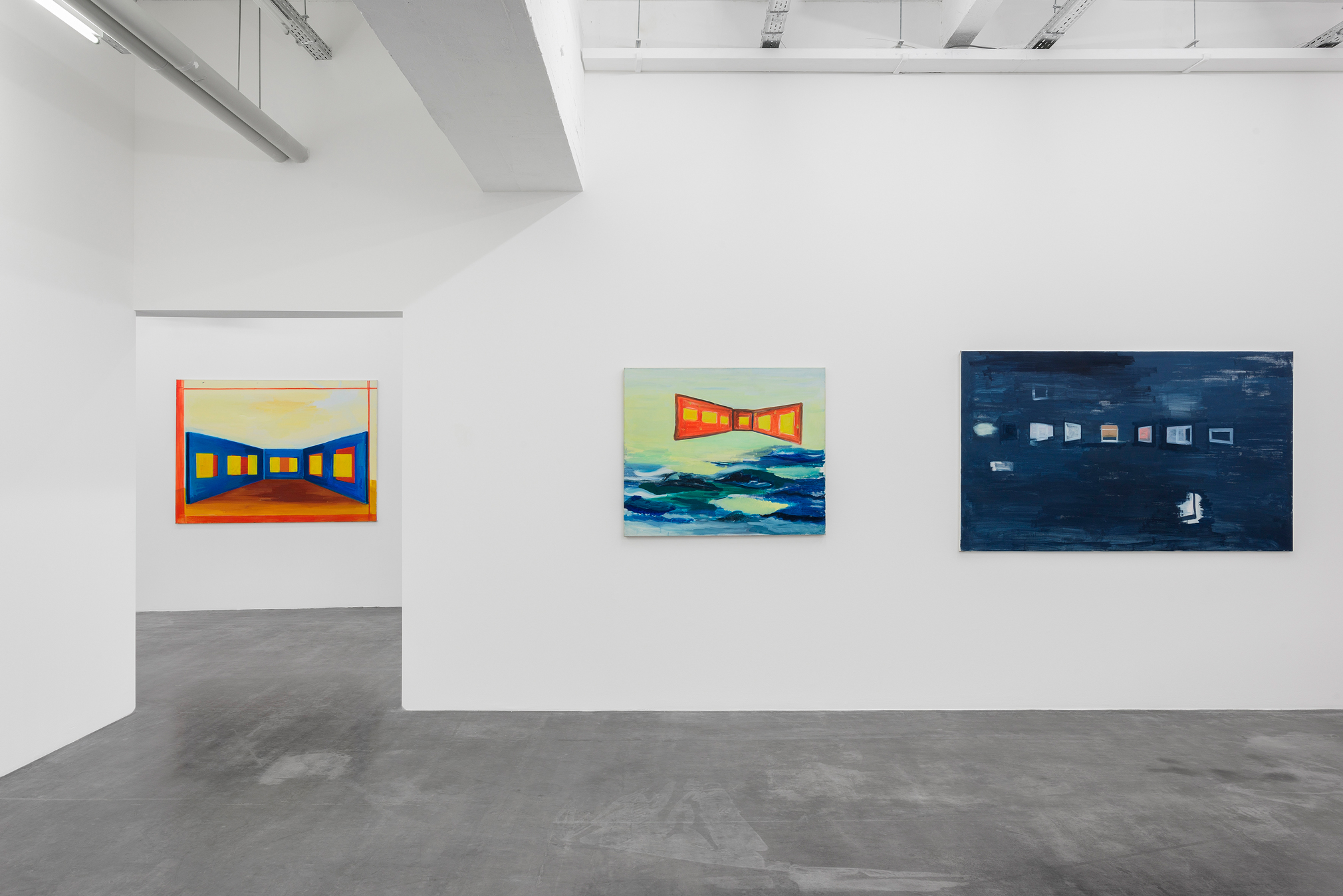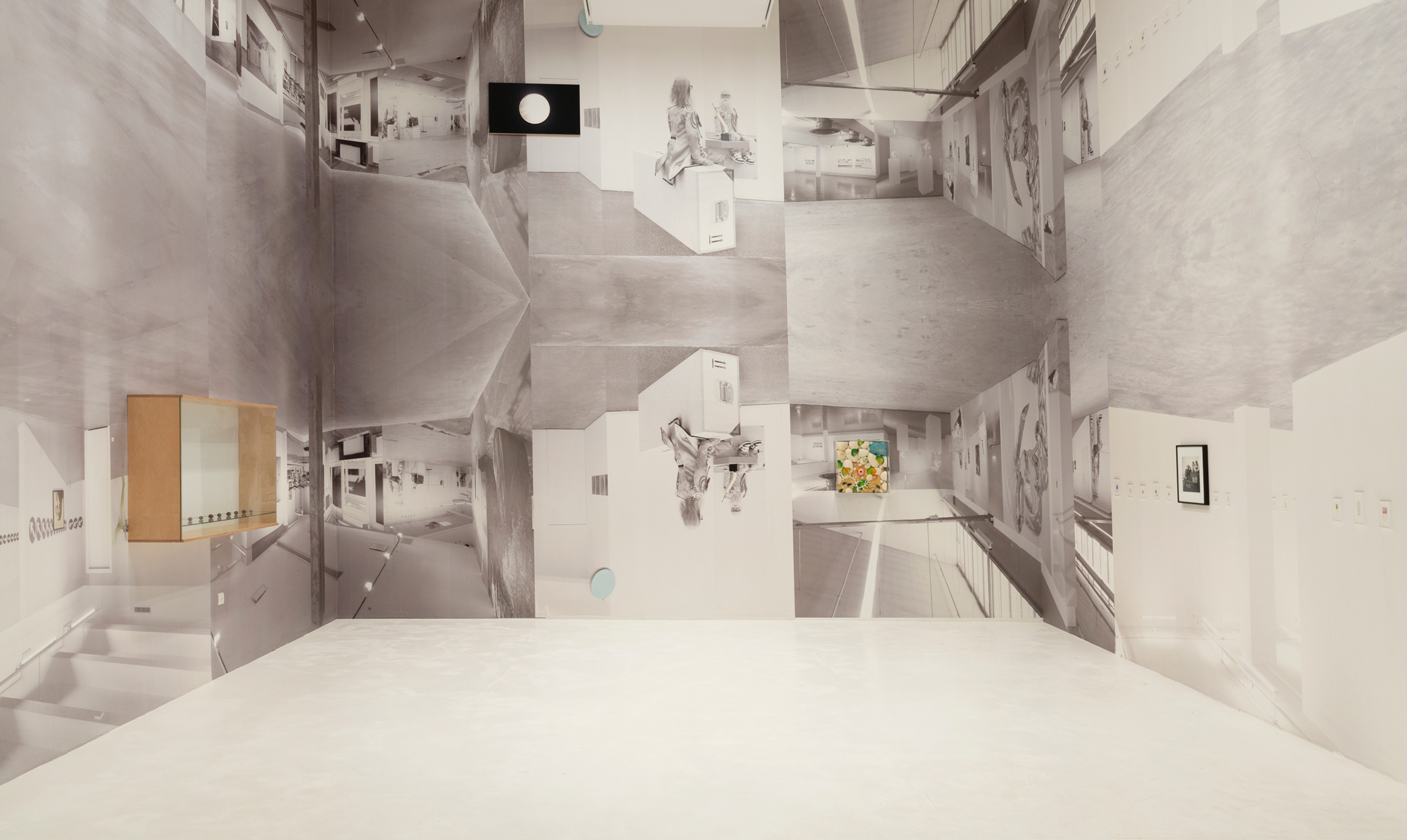A picture of a picture: Jonathan Monk on René Daniëls
At the show with the artist: Jonathan Monk includes views from other shows as a scenography, a mise-en-abyme reminiscent of René Daniëls’s paintings of exhibition views
I like to think of Jonathan Monk as a pop artist in a world where “pop” corresponds to the art world. (Imagine Andy Wharol leaving his mundane soups and other products aside, picking his subjects from other artists’ works and the institution that surrounds them.) Monk can count on enough awareness of his working environment, its codes and history, to elevate his own art to the level of commentary–in an exquisitely post-modern way, a fun commentary even. There are some straightforward choices, like his deflating a Koons rabbit (Deflated Sculpture No 1, 2009) or peeing on a Serra sculpture (the early In war time, this would be a tank (Pissing on Serra), 1994), but also more sophisticated uses of other people’s art, especially a project of updating Minimal art from the 1970s for a time that’s changed. (Monk seems to want to find the relevance of the art historical movement in a context – his – where political ideologies are radically different, if not entirely gone.) Even when things are familiar to lay people, for example the children’s drawings he’s used in installations, or a reflection on the ancestral father/son relation in his Father & Son Walls, 2016, he re-injects the art world in his pieces through other people’s art: the children’s drawings are found in a John Baldessari book; the father/son’s brick wall is used to hang artworks from a local collection.

One of Monk’s series is what he calls “Exhibit Models”: installation views from his or someone else’s exhibitions, printed and glued on walls that occasionally accommodate other works. A collage is created, sometimes spiralling into infinite: actual works appear next to printed works that contain other works and so on. Visitors to CFAlive in Milan will witness the last episode in this series, realized for the Three Star Book exhibition of pieces by some eleven artists from the Parisian publisher’s catalog. In a recent conversation, Monk confirms he never quite understood the idea of a group show as a sequence of mini solo shows. “I like when works disturb each other,” he says, sounding like he is again commenting on the art world’s standard practices. I am told the “Exhibit Models” series started off at Kunsthaus Baselland during Art Basel to go against, for better or worse, a more classical presentation of “products”, the otherwise typical purpose of the commercial and fundamental art world’s event in Switzerland.
Monk’s attitude is too close to humor to be called subversive though. In this sense it is reminiscent of René Daniëls’s “bowtie” paintings, which we both saw at Wiels in Brussels before they became the subject of our exchange here. No bowtie, they are instead depictions of exhibition views, rendered in pictures that, despite their flatness, remind the artist himself and us the spectators of where, albeit temporarily, we really are: the art world. The artist’s step outside his context and look back into it, hinging on a typical postmodern self-awareness inflated with wit, is not far in spirit from Monk’s. For our “At the Show with the Artist” series, I asked him about his affinity with the 1980s Dutch painter, developing an idea for a topic of conversation he luckily had.

***
René Daniëls’s “bow tie”, the vanishing point exhibition view he extensively repeated in his paintings between 1984 and 1987, has been read as his comment to the act of looking, even memory itself. I believe he was instead motivated by concerns that were not so much philosophical as they were institutional, fiddling with the codes of the art world of his time – the increasingly important white cube and fair booth – with humor. (As a thought experiment, think of Daniëls’s gallery view paintings as one of those Hieronymus Francken II 17th century depictions of art collections, stripped of its documentary force but loaded with wit and commentary.)
To what extent does your wallpaper work, which also includes installation views, share Daniëls’s concerns in terms of institutional critique?
Jonathan Monk: Before now I’d never actually seen my work within the context of institutional critique. I guess it relates in some way and does share similar concerns but certainly needs walls as a supporting structure. Institutional critique does seem to be a slightly outdated concept. A lot of art museums embrace the work that is critical of their process. Initially the Exhibit Model series of installations was realized as a way of making a large exhibition that required very little shipping. The actual work didn’t need to move – only the documentation was required to build a new piece. It allowed me to connect works that had never been shown next to each other and to allow gallery spaces in different countries to flow into each other. I always enjoyed René Daniëls’s’ simplified installation paintings – sketches of possible exhibitions. Perhaps now due to the proliferation of the art fair booth his paintings seem to relate directly to this point of sale. The bow tie like floating perspective view of works on three walls seems to have been years ahead of its time. The original motive simplified to the point of no return. The pop-up window of a screen within a screen is probably how most art is viewed these days; the documentation being easier to digest than the real thing.


Except for a semi-transparent white patina, the painting by René Daniëls titled Doorlopend naar buiten is almost an identical copy of his own paintings Untitled and De terugkeer van de performance, executed approximately at the same time. You are known to incorporate works by other artists in your own, and with the wallpaper pieces, you have incorporated your own in your own. Daniëls’s self-appropriation can be read as yet another of his own ways to declare that painting was alive after the conceptualist incubation of the 1970s, or at least to treat figurative art with an obligatory amount of skepticism after it fell out of the critic’s fashions.
You are working in an entirely different art historical moment and medium; I wonder what self-appropriation means to you?
Jonathan Monk: Including my work within my work seems very natural to me. Self appropriation feels like an odd term. I think I am more interested in re-examining earlier works – seeing how things from different periods can or can not sit together. I assume this particular series will vanish within the void of its own documentation. As you mention, the idea of appropriation today is very different from its late 70’s beginnings. The ease at which this can be done today is incredible… anything can be copied and redistributed as an original within minutes – I do find it funny that some artists get annoyed when their images or style are copied. Sol LeWitt told me that once an artwork of his is out in the world it is there for everyone to use and abuse. Control is lost once a piece leaves the studio. When I use the works of other artists within my work I am also trying to make connections either visually or conceptually. The work of certain artists has followed me for years, has become an important controller of my process so I try to embrace this logic. It is all research material that hopefully gives me a better understanding of my project. I’d love to include a René Daniëls bow tie piece from the mid 80’s within one of my Exhibit Model installations – not sure it’ll ever happen but maybe…
February 10, 2023
